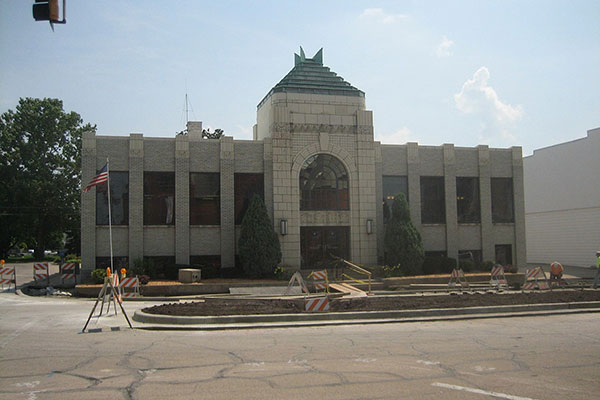
Learn how Clariti's permitting and licensing software helps governments deliver exceptional experiences online.

Edit this rich-text to provide the visitor with all appropriate information. You might add images, calls-to-action, horizontal rules, videos, quotes, etc. All this and more can be done through the text editor.

When a state government’s legacy system becomes more of a problem than a solution, it’s time for a change.
That’s what Erika Hoppes, a business analyst in the state of Michigan's liquor division, realized with their old Oracle system. It was custom-built to a point where it was no longer viable for future use.
“The anticipated cost of upgrading was going to increase significantly,” she recalled. “The support for that system and the resources required dwindling. We really were looking at something a little more modern. And as far as maintenance was concerned, we needed to make sure that we had a system that actually had support.”
System integrator Deloitte offered a perfect solution: Clariti, A cloud-based permitting and licensing and solution, the only one of its kind built on the Salesforce platform.
“Deloitte was actually the one who approached us,” Erika said. “They explained how Clariti has this package that a lot of governmental units are using, and how the out-of-the-box functionality keeps them from having to customize things on their end.
"With the go-live-date we were working toward, it made so much sense for us to go ahead and use an existing package.”
“Deloitte and Clariti worked all night long to get up an implementation approach, and by the time they showed up, they had a plan they were ready to implement and a plan B if necessary."
“They made sure we were taken care of and ensured it happened within our timeframe. It isn't always the case with every company that you’re working with. Not everybody makes themselves available.”
Michigan has been using Clariti's licensing and permitting solution in its Liquor Division since 2015. This unit depends daily on the software’s accounting package, and dynamic rules and letters engines.
Clariti’s accounting package allows the division to provide accurate compliance reporting, ensuring their capability to efficiently meet state requirements.
“It was necessary for us to have a system that allowed us to match payments and split that out. We needed it for our reporting and managing of fees that come back out through our Sigma system.”
"As far as the accounting side of it, with the way that we have to report on our fees and make those payments and the visibility of those types of things, it has worked out really well.”
Clariti’s dynamic rules engine gives the unit the ability to establish its own rules and workflows to meet their unique process requirements. Scalable to suit the department’s needs, the letters engine automatically crafts all physical correspondence needed for the permitting and licensing process.
“We generate renewal notices for each business based on the type of business or status,” described Erika. “It packages that up and puts it into a PDF for us, allowing us to scrub the PDF for accuracy.
“The letters engine side of things is impressive. We’re coming into our first triennial year with our system and we’re going to be renewing in the neighbourhood of 30,000 licenses."
“Clariti was great to work with. The support has always been really great for our development team and for us. They know us and make it a point to know our systems.
“Anytime we had a question on anything in the system that was their cup of tea, they were on it. Within 24 hours, we usually had an answer, and we could move forward. As far as customer service goes, they are one of the best vendors I've ever worked with.”

Taking an elevator should not be a risky proposition. Yet recently more than 10 percent of elevators in Massachusetts did not comply with safety inspection requirements.
To help expedite inspections, the state turned to Clariti. A cloud-based solution, Clariti helps governments streamline permitting, licensing, and compliance processes, including safety inspections for elevators. The result is a transparent process for applicants that cuts down on approval times.
“We wanted a product that ensured happy customers externally,” explained Ellen Christy, CIO of Massachusetts professional licensing unit. “It had to be seamless and adopted by the business owners quickly.”
Clariti is the only solution of its kind built on Salesforce, a platform used by hundreds of organizations across the world. Users appreciate the intuitive interface and scalability. One of the state’s own departments was already using Clariti with great success, which gave Ellen’s team confidence moving forward.
“When we were transitioning, I lived on a weekly call with the Clariti leadership team,” Ellen recalled. “It was a big transition with multiple systems and hundreds of people trying to figure out how to support the system. It was going into the unknown.
"The Clariti team was really good about settling the dust and making us feel comfortable. Knowing the support was there as we went along was a big plus.
“We can’t have systems that are always down or have issues. I mean, I do have those systems. I wish I didn’t, but I do. And it’s disruptive. But I don't have those situations with the Clariti product at all.
“I don't hear from our business users on the platform’s instability, its operation, or functions being problematic. For me, that says it’s an excellent product to support from an IT perspective. It just helps take one item off my list that I’d have to worry about.”
With the number of skyscrapers and buildings on the rise—and audits and public safety inspections increasing—Massachusetts will continue to work with Clariti to ensure satisfaction between citizens and civil servants is met through streamlining their workflow processes.
“Clariti is always available.” Ellen continued. “If we reach out to make improvements to the system, they’re quick to turn around a proposal. Even going further by digging deeper into what we’ve asked for. They define the requirements, offering suggestions on how their platform could do things differently.
“It’s a good company. It’s easy and hassle-free for me, and that’s important. Believe me, I have other systems that could be more streamlined, they require more oversight and hold a lot of complaints as they’re not intuitive.
“It gives us a level of confidence, knowing how Clariti knows their products and the industry. That’s really important to us. I find them very attentive and very responsive. If we have any issues or have a question, they’re always willing to jump on a call—or a plane—to help us understand what we’re looking for.

For the past 11 years, the City of Sterling and Clariti have been working together to deliver seamless community development, public safety and economic prosperity for its residents.
From administering building permits to planning and zoning functions, contractors and administrators can effectively manage community processes with a simplified, intuitive platform.
Prior to adopting Clariti, the City of Sterling had a two-carbon copy manual system where users had to write out permits, physically distribute them, and then enter them back into excel to prepare monthly reports.
“There was a lot of paperwork, and it was a pain.” - Hilda Thielen, City of Sterling
With Clariti, City of Sterling’s Code Enforcement Secretary Hilda can now manage all permits, complaints, contractor accounts and building reports within one system, making it easier to make end-of-month data synthesis with centralized data.
“When our teams hold administrative hearings, they can add details or other notes into the system’s records,” said Hilda. “I can also see who my inactive and active contractors are, so when I make reports for electrical contractors and general contractors, it’s a lot easier.”
For the City of Sterling, finding permits is quick and easy. “When I’m searching for permits, I just switch the internal settings to “parcels” and the system automatically searches through everything,” said Hilda.
“It meets everything we need.” - Hilda Thielen, City of Sterling
In a society where social distancing and remote work are necessary, visiting the office, filing paperwork, and accessing on-premise files isn’t realistic. This is one reason why true-cloud solutions are overwhelmingly popular for business operations, and public-sector organizations are now realizing the benefits, too.
“It’s been great being able to access information whenever I need it.” - Hilda Thielen, City of Sterling
Clariti is built on the Salesforce platform, globally recognized for its configurable user interface and intuitive user experience.
Hilda’s team at the City of Sterling can configure new workflows, automations, applications or programs themselves, “without the need to step into the office or call someone. Right now, we can’t take people into the office so we can do everything at once without any in-person interaction.”
It’s a good thing City of Sterling already had Clariti implemented across their workforce and municipality before COVID.
With the Clariti platform, Hilda can see exactly what’s been done each day and what still needs work the following day.
“Our teams are pretty good about entering relevant information onto the platform and closing out complaints. When they close it, I know they’ve taken care of it.” With insight into task completion, Hilda can make sure that nothing gets dropped, ensuring ownership and transparency across teams and departments.
Clariti also delivers easy access to information, when you need it. “When our inspection team runs administrative hearings, they can attach a note to the system to say ‘this person didn’t comply,’ or leave other important information for the case.”
Permitting is also easier for the City of Sterling, with comprehensive and robust data sourcing across every single file. “When I do my permits, I can go back and look at an address and see if there’s a complaint attached to that address when residents are asking. I can plug in the resident name, applicant or contractor, and the platform pulls all of the relevant information right up.”
Hilda can easily manage the city’s contractors and see the necessary data that comes with maintaining those relationships, from insurance information to permit expiration. “Our contractors can always keep their information updated, and inspectors can enter data on-site or in their vehicles, with real-time access into how many times an inspector has been there.”
And if someone needs to send a letter to residents? With Clariti’s automated letters engine, the City of Sterling’s employees can draft and send instantly generated letters personalized for their recipients. All it takes is a simple click and drop of the information into the form, and the product does the rest.
Our commitment to customer success means finding and providing the best experience possible when solving your governing problems.
For Hilda, Clariti’s platform and capabilities have become an integral part of her everyday work life. “It’s the first thing I have up in the morning, and the last thing I see when I log out.”

Vintage is valuable when it comes to clothing and cars. But not for technology.
Which is why the state of Ohio turned to Clariti to expedite its workflow processes and approve licenses and permits for the general public and businesses. Through the government software, the department of administrative services has achieved impressive results, digitally transforming their capabilities for years to come.
In a word – futureproof.
Lane Wood, the state of Ohio’s e-Licensing program manager, recalls that his office had gone as far as it could with its old CAVU legacy system.
“Our old system started as a commercial, off-the-shelf package. But to meet our needs over the years we ended up configuring so much that we could no longer apply vendor patches to it, it became so customized.
“It was vintage, early 2000s technology and we needed an upgrade. We had scaled to a point where it was difficult to support the number of agencies, boards, and commissions than we had in our system at the time.”
After one final attempt to modernize their outdated system in 2015, the state put out a request for proposal for a new platform.
Deloitte, a leading system integrator, responded with Clariti as an integral part of their solution. While other vendors proposed building a custom system from the ground up, Clariti gave Deloitte a leg up with its built-in permitting and licensing functionality.
“The amount of configuration versus customization that the Clariti package brought to the table,” continued Mr. Wood.
Clariti’s dynamic rules engine provides the state the ability to establish its own unique permitting, licensing, inspection, and code enforcement systems for their specific needs. The Salesforce platform delivers a long-term solution and a beautiful user interface, providing a secure, flexible and scalable solution. As a result, the system is easily configured to meet Ohio’s specific needs and complex workflows.
“Two years into our project, there was some legislation passed here in Ohio that consolidated a number of our boards together,” explained Mr. Wood. “The fact that we were on Clariti and had a building block that rode on top of the Salesforce platform provided a leg up for us to easily consolidate those boards in the system.
“The Clariti and Salesforce platform gives us the elasticity to grow as needed, and the cloud has the capacity to always be there for us.”
Since its implementation, Clariti has helped the state accommodate 221,000 submitted licensing applications, 1.1 million renewals or reinstatements, 225,000 service requests, and 38,000 complaints filed within their system.
To date, the permitting and licensing software provides solutions for all of their professional licensing. Housing all 21 agencies, boards, and commissions, 246 license types, and information on 800,000 currently licensed individuals and businesses.
With its success, Mr. Wood is an advocate for the Clariti solution—giving it a 10 out of 10 rating—and has since recommended it to other agencies in the state.
“Not only have we gone along with the package solution that we built and put in place,” explained Mr. Wood, “but we've shared the Clariti-Salesforce configuration with another agency here in Ohio that picked it up and implemented some licensing on top of it.

Featured
Edit this rich-text to provide the visitor with all appropriate information. You might add images, calls-to-action, horizontal rules, videos, quotes, etc. All this and more can be done through the text editor.